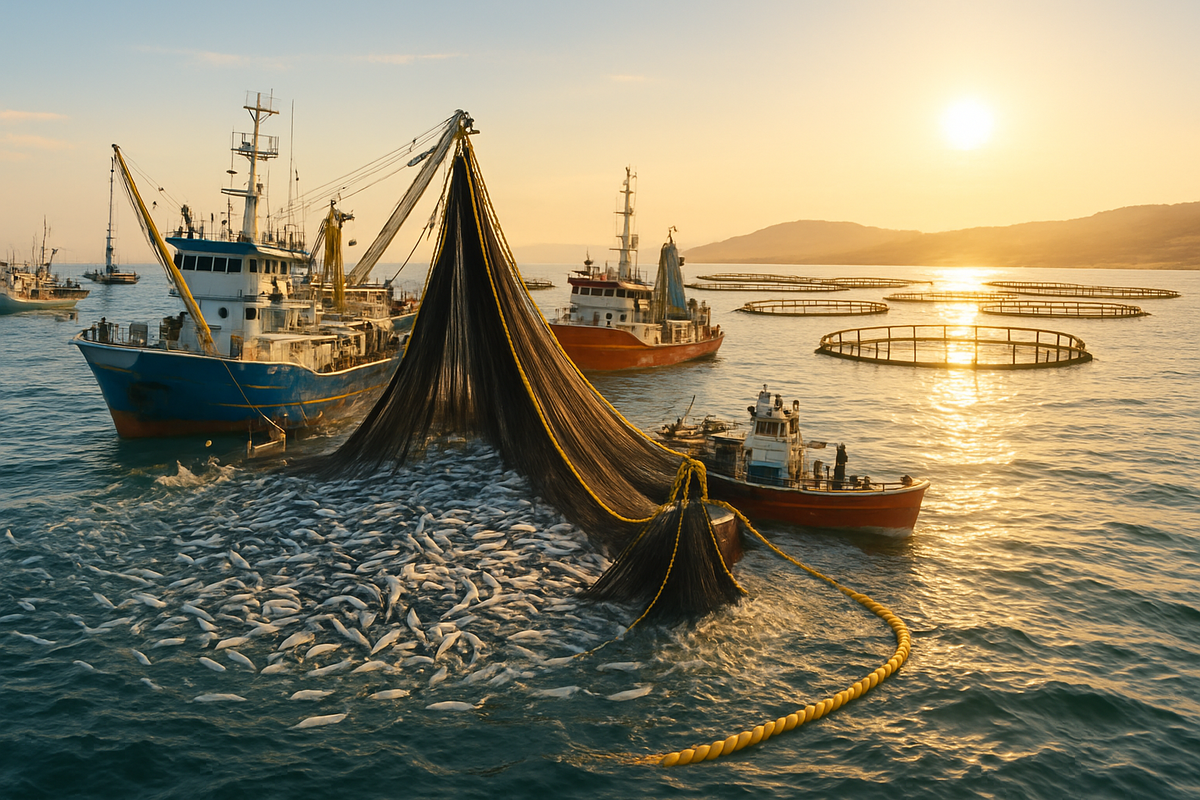
The global aquaculture industry is breathing a collective sigh of relief as new data, current as of October 6, 2025, confirms a significant upward momentum in global fishmeal and fish oil production. This robust recovery, primarily fueled by a strong resurgence in Peruvian anchovy fisheries, marks a crucial turnaround after a period of severe supply constraints and soaring prices. The increased availability of these vital marine ingredients carries immediate implications for aquafeed manufacturers, potentially stabilizing feed costs and supporting the continued growth of the global seafood market.
This positive shift comes at a critical juncture, offering a much-needed boost to an industry grappling with the complexities of sustainable growth and fluctuating raw material costs. While the immediate outlook appears brighter, the long-term sustainability of marine ingredient supply remains a pivotal concern, setting the stage for ongoing innovation and strategic adaptation within the aquaculture sector.
Detailed Coverage: Peru's Resurgence Fuels Global Supply
The driving force behind this impressive rebound is the Peruvian anchovy fishery, a cornerstone of global fishmeal and fish oil supply, which accounts for approximately 20% of worldwide production. After a challenging late 2023, marked by a cancelled fishing season due to the El Niño phenomenon, Peru's fishery has staged a remarkable comeback. A successful 2024 season, yielding 2.5 million metric tons of anchovy in just 40 days, laid the groundwork for the current momentum. Through 2025, fishing activities in Peru have continued robustly, extending into late July, further bolstering output and exceeding previous year's figures.
Globally, fishmeal production through August 2025 has seen an approximate 8% increase year-on-year, with fish oil output also rising by about 4%. Earlier in the year, the growth was even more pronounced, with cumulative fishmeal production up by 29% and fish oil by 34% through March 2025 compared to the same period in 2024. The Marine Ingredients Organisation (IFFO) maintains its 2025 estimates of 5.6 million tons for fishmeal and 1.2-1.3 million tons for fish oil, indicating that current production is largely on track with industry expectations. While Peru, Chile, the USA, Spain, and several African nations have contributed positively, some regions like Northern Europe, Iceland/North Atlantic, and domestically, China, have reported declines or slower growth in marine ingredient output.
The immediate market reaction has been one of welcome relief for aquafeed producers. The previous scarcity of fishmeal and fish oil had driven prices to historic highs, forcing many to reformulate feeds with alternative, often more expensive, plant-based ingredients. The increased supply has begun to temper these prices, although they remain elevated compared to historical averages. Crucially, demand from the aquaculture sector remains exceptionally strong, particularly in China, which is currently in its peak aquafeed production season. This sustained demand, coupled with improved profitability for certain farmed species, ensures that the increased supply is readily absorbed by the market, preventing a drastic price collapse and instead fostering a more stable environment for planning and investment.
This recovery is particularly significant given the rising costs of traditional plant-based feed ingredients such as soybean meal, corn, and rapeseed meal. A more stable and potentially moderated price for fishmeal and fish oil could make these marine ingredients a more attractive option, allowing for greater flexibility in feed formulations and potentially improving the nutritional profiles of aquafeeds. However, industry experts also temper optimism with caution, reminding stakeholders that wild fishery resources are nearing sustainable limits and climate change continues to pose long-term risks to supply stability, suggesting this current recovery might be a temporary reprieve.
Companies That Might Win or Lose from the Surge
The recent surge in global fishmeal and fish oil production is poised to reconfigure the competitive landscape within the aquaculture and animal feed industries, creating distinct winners and losers. For aquaculture companies, particularly those farming carnivorous species like salmon and shrimp, the increased availability and potential moderation of prices for these essential feed ingredients represent a significant boon. Feed costs typically constitute a substantial portion (50-70%) of their operational expenses, so a reduction here directly enhances profitability and competitiveness. Major salmon farming companies such as Mowi (OSE: MOWI), SalMar (OSE: SALM), Grieg Seafood (OSE: GSF), Lerøy Seafood Group (OSE: LSG), and Icelandic Salmon (OSE: ISLAX), which is 51% owned by SalMar, stand to benefit from lower feed costs, bolstering their margins and potentially supporting expansion. Similarly, shrimp farmers like NaturalShrimp Inc. (OTCQB: SHMP) and India's Avanti Feeds Ltd. (NSE: AVANTIFEED) could see improved profitability.
Conversely, pure-play fishmeal and fish oil producers, especially those heavily reliant on specific wild fisheries, might face new challenges. Companies like Peru's TASA (Tecnológica de Alimentos S.A.), Austral Group S.A. (BVL: AUGUR), and Exalmar S.A.A. (BVL: EXALMAR), along with Denmark's FF Skagen AS, could experience downward pressure on prices if the increased supply outpaces demand growth. While higher sales volumes might partially offset this, their pricing power and profit margins could be squeezed. Diversified marine ingredient companies such as Pelagia Holding ASA (part of Austevoll Seafood ASA (OSE: AUST)), Omega Protein Corporation (owned by Cooke Inc.), and Mukka Proteins Ltd (NSE: MUKKAPRO) will need to balance increased volume with potential price deflation.
Perhaps the most significant impact will be felt by companies specializing in alternative feed ingredients. The drive for sustainable aquaculture and the previous scarcity of marine ingredients had fueled substantial investment in novel protein sources like insect meal (e.g., Innovafeed, Ynsect), fungi-based proteins (e.g., Enifer), and algae-derived omega-3s (e.g., Veramaris, a joint venture between DSM and Evonik; Corbion (AMS: CRBN)). If traditional fishmeal and fish oil become more abundant and cost-effective, the economic incentive for aquafeed producers to switch to these often more expensive alternatives might diminish. This could slow the adoption rates and scaling efforts of these innovative companies, forcing them to re-evaluate their market strategies and emphasizing the long-term sustainability narrative over short-term cost savings. Large feed manufacturers like Cargill, ADM (NYSE: ADM), and Nutreco, which have invested in both traditional and alternative portfolios, will experience a mixed impact, benefiting from cheaper conventional ingredients while potentially seeing slower returns on their alternative ingredient R&D.
Wider Significance: Navigating Sustainability and Food Security
The upward trajectory in global fishmeal and fish oil production, while offering immediate relief to the aquaculture sector, carries broader significance that resonates across critical industry trends, from sustainable aquaculture to global food security and marine resource management. This event underscores the delicate balance between meeting escalating demand for animal protein and preserving the finite resources of our oceans.
In the context of sustainable aquaculture, the increased availability of marine ingredients presents a complex scenario. While fishmeal and fish oil are highly nutritious for farmed fish, particularly carnivorous species, their reliance on wild-caught small pelagic fish has long been a point of contention. Critics argue about the efficiency and sustainability of feeding wild fish to farmed fish, especially when those wild fish could directly contribute to human diets. However, a growing proportion of fishmeal and fish oil now comes from fish processing by-products, or "trimmings," which represents a more sustainable approach by optimizing resource utilization. The current surge, if primarily driven by better management of existing fisheries and increased by-product utilization, could be seen as a positive step towards more efficient resource use. Yet, if it encourages over-reliance on whole wild-caught fish, it could undermine the industry's long-term sustainability goals and efforts to reduce the "Fish In:Fish Out" (FIFO) ratio.
From a food security perspective, the implications are equally nuanced. Small pelagic fish, often the raw material for fishmeal and fish oil, are a crucial and affordable source of protein for many vulnerable coastal communities, particularly in regions like West Africa and Southeast Asia. The diversion of these fish from direct human consumption to animal feed can lead to overexploitation, drive up local fish prices, and exacerbate food insecurity in these regions. The current increase in production, therefore, could intensify this competition, making essential protein sources less accessible to the poorest consumers. This highlights the urgent need for robust regulatory frameworks that prioritize human consumption and local food security alongside industrial demand.
Effective marine resource management is paramount in this evolving landscape. Many of the small pelagic fish stocks used for reduction into meal and oil are already fully exploited or overfished. The recent rebound, particularly from Peru, demonstrates the vulnerability of these stocks to environmental phenomena like El Niño. This necessitates strict catch limitations, by-catch limits, and closed seasons based on sound biological advice to prevent depletion and ensure ecosystem health. Historically, price volatility in fishmeal and fish oil markets, often linked to supply shocks from major producers, has been a recurring challenge, driving the aquaculture industry to continuously seek greater feed efficiency and explore alternative ingredients. This event serves as a reminder that while short-term supply might improve, the long-term challenge of finite marine resources and climate change impacts remains, demanding continuous innovation and responsible stewardship.
What Comes Next: Navigating a Future of Innovation and Scarcity
The current upward momentum in fishmeal and fish oil production, while a welcome development, sets the stage for a dynamic future characterized by both short-term opportunities and long-term strategic imperatives for the aquaculture industry. As of October 6, 2025, the immediate outlook suggests a period of relative stability in marine ingredient supply, potentially allowing aquaculture producers to consolidate gains and optimize operations. However, this respite is likely temporary, as the fundamental constraints of wild-capture fisheries and the escalating demand for animal protein continue to exert pressure.
In the short term (1-3 years), the sustained increase in fishmeal and fish oil availability could lead to a temporary stabilization or even slight reduction in aquafeed costs. This offers a crucial window for aquaculture companies, particularly those farming high-value species like salmon and shrimp, to improve profitability and potentially expand production. Strategic pivots during this period will likely focus on optimizing current feed formulations to maximize the nutritional benefits of marine ingredients while also continuing to explore more efficient inclusion rates. Aquaculture companies will also need to bolster their strategies for managing price volatility, perhaps through more sophisticated hedging mechanisms or forward contracts, to mitigate against future supply shocks driven by environmental factors like El Niño.
Looking further ahead (3-10+ years), the long-term outlook for traditional fishmeal and fish oil production remains one of stagnation and inherent volatility. Wild-capture fisheries have largely reached their sustainable limits, and climate change poses an ongoing threat to supply stability. This necessitates an aggressive and proactive pivot towards sustainable and economically viable alternative feed ingredients. Significant investment and commercial scaling will be required for novel protein sources such as insect meal (e.g., from black soldier fly larvae), single-cell proteins (like yeasts and microalgae), and algal oils rich in omega-3s, which offer a direct substitute for fish oil. The industry will increasingly integrate circular economy principles, maximizing the utilization of seafood by-products beyond basic meal and oil.
Market opportunities will emerge for biotechnology and feed ingredient companies that can successfully develop and scale cost-effective, nutritionally complete alternative feeds. This transition will not only secure the future growth of aquaculture but also enhance its environmental credentials, appealing to a growing segment of health- and environmentally-conscious consumers. However, challenges persist, including ensuring the appropriate nutritional profiles for diverse aquaculture species, achieving economic viability at scale, and navigating regulatory and consumer acceptance barriers for novel ingredients. The overarching outcome will likely be a more diversified and sustainable aquaculture industry, where fishmeal and fish oil remain important, but as premium or strategic ingredients, possibly sourced almost entirely from by-products, while a broad portfolio of alternatives drives the bulk of feed production.
Comprehensive Wrap-up: A Market in Transition
The strong start to global fishmeal and fish oil production in 2025, primarily driven by a robust rebound in Peruvian anchovy fisheries, offers a critical reprieve to the rapidly expanding aquaculture industry. As of October 6, 2025, the market has seen increased availability and a potential tempering of prices for these vital marine ingredients, providing a much-needed boost to aquafeed producers and farmed seafood operations. This immediate positive shift underscores the indispensable role of fishmeal and fish oil in supporting global protein production and efficient aquaculture growth.
However, this current momentum exists within a broader narrative of increasing scarcity and volatility. While 2025 has shown a positive trend, the underlying reality is that wild-capture fisheries, the primary source of these ingredients, are largely static or nearing their sustainable limits. Forecasts from RaboResearch and other analyses indicate potential fishmeal shortages as early as 2028, with fish oil scarcity intensifying throughout the decade. This looming supply-demand imbalance, exacerbated by the unpredictable impacts of climate change and recurrent El Niño events, is poised to drive heightened price volatility and establish higher price benchmarks in the long run.
The lasting impact of this period will depend significantly on the industry's strategic response. The current increase in production, particularly if it stems from improved by-product utilization and responsible fisheries management, can serve as a valuable bridge, allowing time for accelerated investment and scaling of alternative feed ingredients. The imperative for the aquaculture sector is clear: to continue its aggressive pivot towards sustainable alternatives such as insect meal, single-cell proteins, and algal oils. This transition is not merely an economic necessity but a foundational shift towards enhancing the environmental credentials of aquaculture, ensuring its long-term viability as a sustainable source of global protein.
For investors, the coming months will require vigilant monitoring of several key indicators. Watch for updates on Peruvian fishing seasons and quotas, as these remain a dominant influence on global supply. Closely track climate and environmental forecasts for major fishing regions to anticipate potential supply disruptions. Chinese demand indicators, particularly related to aquaculture output and pig farming profitability, will heavily sway market dynamics. Crucially, keep an eye on advancements in alternative feeds, as significant breakthroughs and commercial adoption in this area could fundamentally reshape demand patterns for traditional marine ingredients. Finally, regulatory and sustainability developments, including the increasing push for certifications like MSC and ASC, will guide market preferences and investment opportunities in a sector striving for both growth and environmental responsibility.
This content is intended for informational purposes only and is not financial advice





